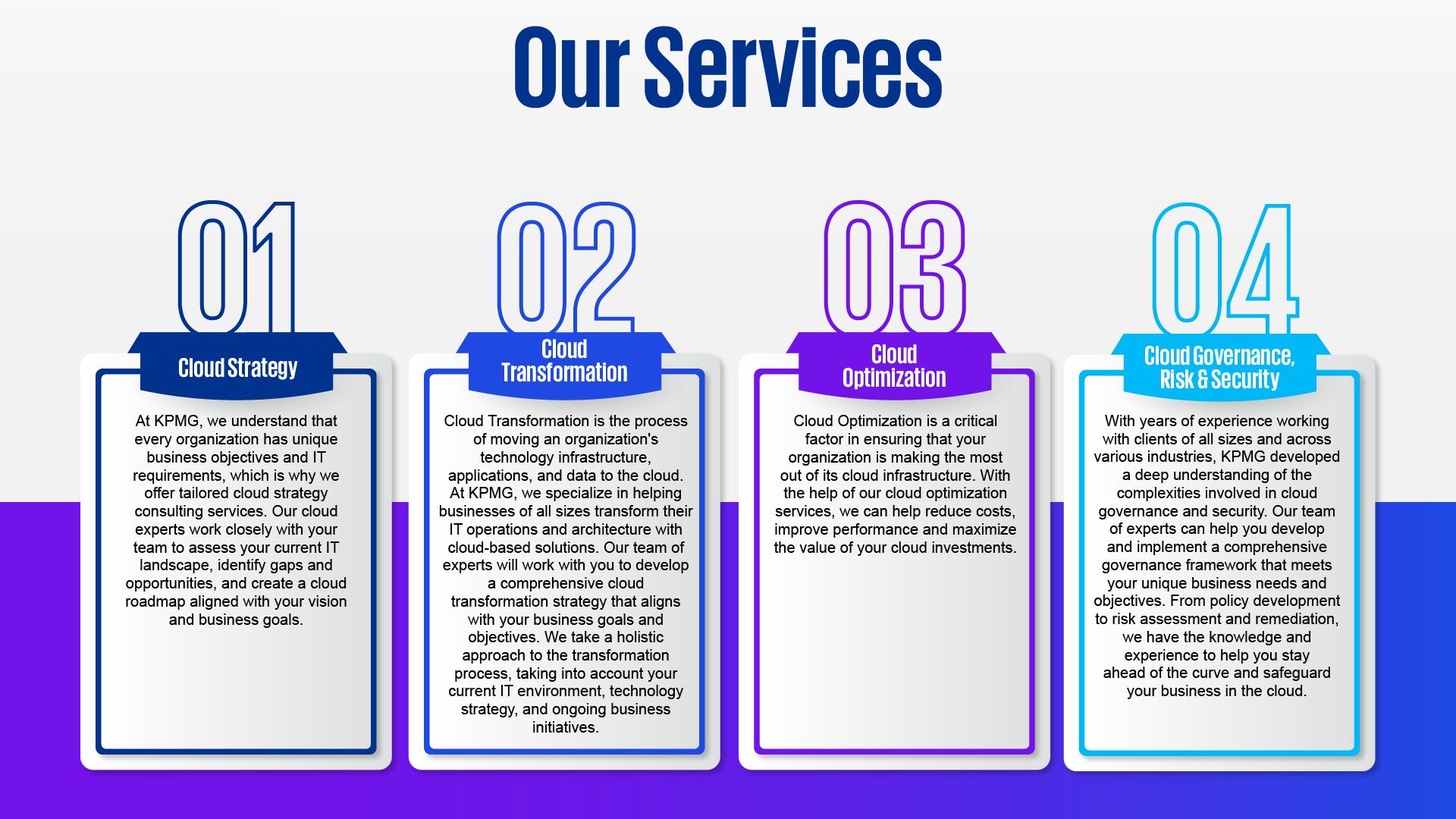Cloud computing has reached a level of maturity, and its widespread adoption is a direct result of the transformative benefits it offers, including improved agility, flexibility, and scalability. As a result, many organizations are now prioritizing a cloud-first approach as part of their digital transformation strategies. To meet the challenging demands of these organizations, cloud services must provide secure and on-demand access to network, compute, build capacity, application platforms, software, and service management.
At KPMG, we understand the importance of cloud services in transforming businesses and accelerating growth. That's why our Cloud Services are designed to deliver solutions that provide a trusted cloud environment, ensuring secure and reliable access to all the services and resources you need. Whether you're looking to optimize your IT investments, improve operational efficiency, or enhance customer experience, our Cloud Services can help you achieve your goals and objectives.
With our Cloud Services, you can take advantage of a wide range of solutions, including infrastructure as a service (IaaS), platform as a service (PaaS), software as a service (SaaS), and service management. We work closely with you to understand your unique business needs and tailor our solutions to meet them. Our team of experienced cloud experts is available to provide support at every step of the way, from developing your cloud strategy to implementing and managing your cloud infrastructure.
KPMG's Cloud Services are designed to deliver trusted solutions that will transform your business and accelerate your growth. Contact us today to learn more.
At KPMG, we understand that cloud computing is not just a technology trend, but a critical element for any business strategy. With the right cloud strategy in place, you can harness the power of cloud computing to drive your business forward, increase agility, and enhance customer experience. That's why we're excited to offer our Cloud Services to help you achieve your business goals and objectives.
Our Cloud Services provide a comprehensive range of solutions that help you optimize your IT investments, streamline your operations, and reduce costs. We work with you to understand your unique business needs and tailor our solutions to meet them.
Common Cloud Questions
What are the benefits of moving to the Cloud?
Moving to the cloud provides several benefits, including increased flexibility, scalability, and agility. Cloud services also offer improved security, reduced costs, and better performance. By leveraging cloud technology, organizations can reduce their hardware and maintenance costs, scale up or down as needed, and access the latest technologies and features without the need for significant upfront investment.
What cloud deployment model is best for our organization?
The best cloud deployment model for an organization depends on several factors, including the organization's size, industry, regulatory requirements, and specific use cases. Private cloud deployments offer increased control and security, while public clouds provide greater scalability and flexibility. Hybrid cloud deployments combine the benefits of both private and public clouds. It is essential to assess the organization's needs and evaluate the pros and cons of each deployment model to determine which is the best fit.
What risks do we face by moving to the cloud?
While there are numerous benefits to moving to the cloud, there are also some risks that organizations must consider. These risks include potential security breaches, data loss, and vendor lock-in. To mitigate these risks, it is essential to have a robust cloud security strategy, to carefully select a reputable cloud provider, and to ensure that data backups and disaster recovery plans are in place.
How can we ensure a successful cloud migration?
To ensure a successful cloud migration, organizations must have a comprehensive plan in place that addresses all aspects of the migration process. This plan should include a thorough assessment of the organization's existing infrastructure, the selection of a reputable cloud provider, the development of a migration strategy, the establishment of clear migration goals and metrics, and the training of staff on the new cloud technology. It is also essential to test the new cloud environment thoroughly before fully migrating, to minimize any potential disruptions to the organization's operations.





